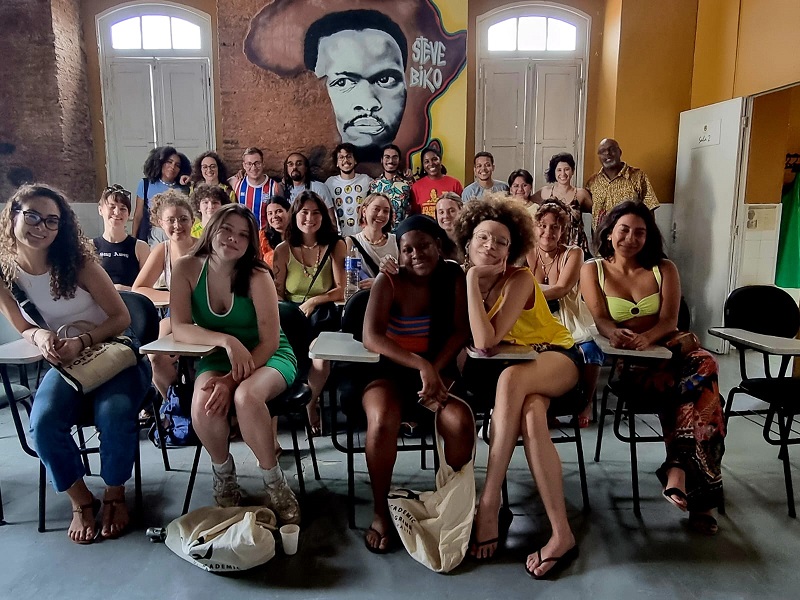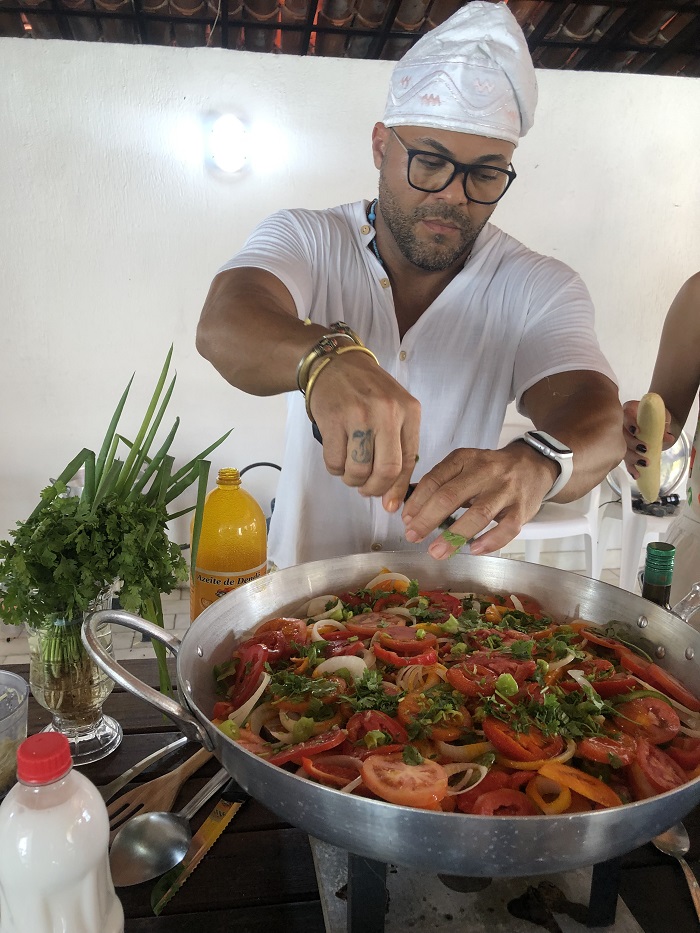Written by Angel Akinleye (Howard University), Student Correspondent for CET Brazil, Spring 2023
Earlier this month, CET Brazil had our Traveling Seminar trip to Salvador, Bahia—a city on the coast of the northeast region of Brazil. Salvador is one of the country’s most historic cities, as it was the first colonial port and capital. The city is divided into two parts: the upper and lower city.
Throughout our seminar, my camera rarely pulled out. Many of the places that we went to were sacred. The people we interacted with were inviting us into their space. Snapping a quick photo felt unbenign. Photography etiquette is to respect the space and people within it. As a blogger, it’s important not only to be authentic but to be ethical.

Group photo at the Steve Biko Institute
Throughout our week trip, every day was awe-inspiring with activities in both the upper and lower city of Salvador which included the following: the São Joaquim Market, an African-Brazilian cuisine Workshop, Acervo da Laje museum, a Capoeira workshop with Master Valmire and Master Cobra Mansa, Balé Folclórico da Bahia at Pelourinho Theater, visiting the historical city center and Pelourinho area, an African Catholic mass at Nossa Senhora do Rosário dos Pretos church, visiting Quilombo Kaonge and having a workshop on how to make farinha and dende oil, visiting Steve Biko Institute, and a boat trip to two islands.
Food is an important connection for a community’s culture and experience. The process of cooking moqueca at the African-Brazilian cuisine workshop included first chopping onions, tomatoes, garlic, and pepper. Onions are the base at the bottom of the pan. Then you put fish over the top after you take all of the cut tomatoes, garlic, and pepper and put it over the fish. Then we put coconut oil and dende oil and let it fry. Once simmered, shrimp is added, as well as a few spices. We also cooked caruru, vatapá, and xinxim de galinha.

Afro-Brazilian cuisine workshop instructor making moqueca
“What is Capoeira?” Cobra Mansa asked us as we sat in a circle. Is it a dance? A martial arts movement? It is both the once outlawed practice that thrives on preserving Afro-Brazilian culture. We went across the floor doing cartwheels and crouching feet kicks. The movements were fun and I enjoyed the athleticism as we moved to the beat of the drums. I was excited to play the instruments, most of all the berimbau. I had never seen or even heard of the berimbau before that day. Master Valmire and Master Cobra Mansa were very loving and encouraging throughout the class, motivating us to keep trying and not give up.
Candomblé has a great meaning in Bahia, Salvador. It was very present almost everywhere during our trip. Candomblé is a religion brought to Brazil by enslaved people from Africa. They brought their own local religions, which were mixed from different tribes. Some of these tribes included Yoruba, Bantu, and Gbe in West Africa. Candomblé has orixás which are deities that are in control of different things. For example, Xangô is an orixá who has control over lightning and thunder. During the trip, we visited Casa de Iemanjá, a sanctuary house for the Orisha named Yemanjá. She is the deity of the river that flows into the sea. The fisherman brings gifts that she likes to the sanctuary in hopes to make her happy and keep the sea calm.
Terreiro are the places where people practice Candomblé. There are more than one hundred terreiros in Salvador, Bahia alone. Going to Quilombo Kaonge was the most special experience. We were able to visit a terreiro and speak to the community elders. You may be wondering what a Quilombo is. Quilombos are Brazilian communities originally formed during colonialism for enslaved people to escape the chains of slavery. It is a space of resistance of people with African heritage. As an African American attending an HBCU, going to the Quilombo and being in Bahia, Salvador, which has the largest population of people of Afro descent outside of Africa, has been a life-changing experience. The Quilombo opened my perspective and taught me about different ways of living, such as circular thinking and different ways to connect with people and nature.
“Being black in Bahia was a cultural and personal experience because all of my life I have struggled with knowing who I am in terms of my identity; therefore, going to Bahia seeing another part of the diaspora and people who look like me having their own culture and unique ways of living was fruitful and irreplaceable experience”
— Vivian Santos-Smith, Howard University
“I think the opportunity to get to travel to Bahia has been my favorite part about our experience in Brazil so far. Not only has it given us a wider perspective of Brazilian culture and Afro-Brazilian heritage, but it gave us the opportunity to have personal shared experiences with members of the community in Salvador. My favorite part was getting to meet the individuals of the quilombo, and was so grateful for their openness to sharing culture with us. It was an unforgettable week”
— Jasmin Johnson, University of Oregon
I would like to thank everyone who helped put together the Traveling Seminar to Salvador, Bahia. To CET Director Súlia Folli and Assistant Director Leandro Tardin, y’all are so amazing for putting that all together! Thank you to all of my professors in Brazil that prepared us for the trip. Thank you to everyone in Bahia, our awesome tour guide Willson and his team. All of my peers that came, you all really made the trip worth remembering. Shoutout to my family and friends because I miss and love y’all.